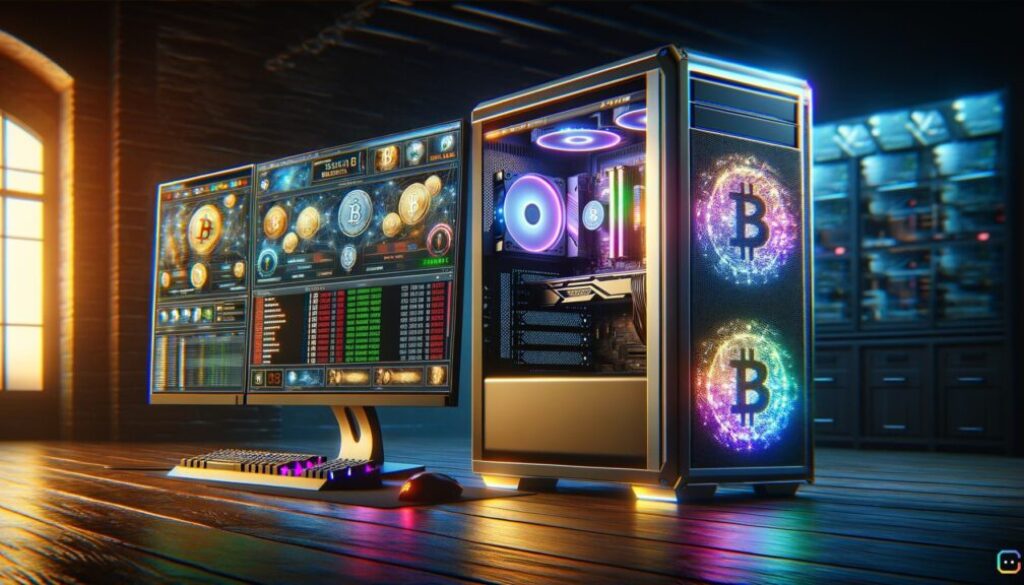Is Bitcoin Mining Profitable with a Gaming PC in 2025?

May 2025 is buzzing with excitement in the crypto world! Bitcoin’s price is reaching new heights, and transaction fees are on the rise, making Bitcoin mining a hot topic once again. From sprawling industrial-scale farms to humble home setups, everyone’s asking: is mining still profitable? For gamers, a particular question often arises: can my powerful gaming PC, with its high-end graphics card (GPU), finally turn a profit mining Bitcoin during its downtime?
While the idea of your gaming rig churning out digital gold is tempting, the reality of Bitcoin mining in 2025 is nuanced. This post will explore whether your gaming PC is up to the task of Bitcoin mining and what alternatives might exist if you’re keen on putting that GPU to work in the crypto space.
What is Bitcoin Mining and Why is it So Competitive?
Bitcoin mining is the backbone of the Bitcoin network. It’s the process by which new Bitcoins (BTC) are created and introduced into circulation. But it’s more than just minting new coins; miners play a crucial role in securing the network. They do this by validating and adding transaction records to Bitcoin’s public ledger, known as the blockchain.
This process relies on a mechanism called Proof-of-Work (PoW). Here’s a simplified breakdown:
- Miners compete to solve extremely complex cryptographic puzzles.
- The first miner to solve the puzzle gets to add the next block of transactions to the blockchain.
- As a reward, they receive a certain amount of newly created Bitcoin (the block reward) plus any transaction fees paid by users whose transactions are included in that block.
To keep the creation of new blocks steady at roughly one every 10 minutes, the Bitcoin network automatically adjusts the mining difficulty every 2,016 blocks (approximately every two weeks). If miners are solving puzzles too quickly, the difficulty increases; if they’re too slow, it decreases. Over time, as more computing power (hash rate) joins the network, the difficulty has consistently trended upwards, making it increasingly challenging to mine Bitcoin.
The Rise of ASICs: Bitcoin Mining’s Specialized Powerhouses
In the early days of Bitcoin, it was possible to mine BTC using a standard Central Processing Unit (CPU) found in any home computer. As Bitcoin’s popularity and value grew, so did the competition. Soon, miners discovered that Graphics Processing Units (GPUs), with their parallel processing capabilities, were much more efficient at solving Bitcoin’s PoW puzzles than CPUs.
However, the game changed dramatically with the advent of Application-Specific Integrated Circuit (ASIC) miners. These are machines built for one purpose and one purpose only: to mine Bitcoin (or other cryptocurrencies using the same algorithm) as efficiently as possible. ASICs offer computational power and energy efficiency for Bitcoin mining that GPUs simply cannot match.
The introduction of ASICs led to a massive surge in the Bitcoin network’s total hash rate. Today, Bitcoin mining is dominated by large-scale operations running thousands of these specialized ASIC machines. For individual miners using less specialized hardware, competing for Bitcoin block rewards has become virtually impossible.
Your Gaming PC vs. Bitcoin Mining in 2025: A Losing Battle?
So, back to the main question: can your trusty gaming PC, equipped with a powerful GPU, profitably mine Bitcoin in 2025? Unfortunately, for direct Bitcoin mining, the answer is a resounding no.
Here’s why your gaming PC isn’t cut out for the Bitcoin mining league:
- Massive Energy Consumption for Low Output: While gaming GPUs are powerful, they are not optimized for the specific type of calculations required for Bitcoin’s SHA-256 algorithm in the same way ASICs are. A gaming PC will consume a significant amount of electricity, but its Bitcoin mining output (hash rate) will be negligible compared to even an older-generation ASIC. This means your electricity costs would likely far exceed the value of any Bitcoin mined.
- Computational Power Disparity: ASICs are orders of magnitude more powerful for Bitcoin mining. Think of it as trying to compete in a Formula 1 race with a go-kart. Your gaming PC, while great for Cyberpunk 2077 or Call of Duty, simply doesn’t have the specialized horsepower to find Bitcoin blocks before ASIC-powered mining farms do.
- ASICs are Built for Efficiency: ASICs are designed from the ground up for maximum hash rate per watt of energy consumed. Gaming GPUs are designed for rendering complex graphics, a different task altogether. This specialized design gives ASICs an insurmountable efficiency advantage in Bitcoin mining.
Even if you have free electricity, the minuscule amount of Bitcoin you might earn wouldn’t justify the wear and tear on your expensive gaming hardware. The immense difficulty and the dominance of ASICs have pushed GPU mining for Bitcoin into unprofitability.
Beyond Bitcoin: Can Your Gaming PC Mine Other Cryptos Profitably?
While mining Bitcoin directly with your gaming PC is off the table, don’t lose hope entirely if you want to leverage your GPU for crypto mining. The world of cryptocurrency is vast, and many alternative coins (altcoins) are designed to be mined effectively with GPUs.
After Ethereum, once a GPU mining giant, transitioned to Proof-of-Stake, many GPU miners shifted their focus to other PoW coins. In 2025, several cryptocurrencies remain potentially profitable for GPU miners. These coins often use different mining algorithms that are intentionally designed to be ASIC-resistant. This levels the playing field, allowing GPUs to compete more effectively.
Some popular and potentially profitable cryptocurrencies for GPU mining in 2025 include:
- Ethereum Classic (ETC): Sticking to its Proof-of-Work roots, Ethereum Classic continues to be a popular choice for GPU miners using the Ethash (or a variant like ETChash) algorithm.
- Ravencoin (RVN): Ravencoin utilizes the KAWPOW algorithm, which is designed to be ASIC-resistant, making it favorable for GPU mining.
- Monero (XMR): Monero uses the RandomX algorithm, which is optimized for CPU mining but can also be mined with GPUs. It’s known for its privacy features.
- Other altcoins that may be viable depending on market conditions and your specific hardware.
A noteworthy point for GPU miners: be aware of your hardware’s limitations. For instance, for mining coins that use algorithms with growing DAG (Directed Acyclic Graph) files, like Ethereum Classic, GPU memory capacity is crucial. It’s anticipated that after September 30, 2025, GPUs with 4GB of VRAM will become obsolete for mining certain cryptocurrencies due to increasing DAG sizes. Always check the specific requirements of the coin you intend to mine.
Key Factors for Profitable GPU Altcoin Mining in 2025
Even if you choose an ASIC-resistant altcoin, profitability isn’t guaranteed. Several factors come into play:
- Electricity Costs: This is often the biggest operational expense. High electricity prices can quickly eat into any potential profits.
- Hardware Efficiency and Cost: The hash rate of your GPU for a specific algorithm, its power consumption, and its initial purchase price are all critical.
- Cryptocurrency Price: The market value of the coin you are mining directly impacts your earnings. Volatility is a constant in crypto.
- Mining Difficulty: Just like Bitcoin, altcoins have mining difficulty that adjusts. As more miners join a network, the difficulty increases, potentially reducing individual rewards.
- Mining Software and Pools: Using efficient mining software and joining a reliable mining pool (which allows you to combine your hash power with others for more consistent payouts) is essential.
Before diving in, use online mining profitability calculators. These tools allow you to input your GPU model, electricity cost, and the coin you’re considering, to get an estimate of potential earnings (or losses).
Conclusion: Smart Choices for Crypto Mining in 2025
So, is Bitcoin mining profitable with a gaming PC in 2025? For Bitcoin itself, the answer is a clear no. The era of casual Bitcoin mining with home computer hardware has long passed, thanks to the dominance of highly specialized ASIC miners and the ever-increasing network difficulty.
However, that doesn’t mean your gaming PC’s GPU has to sit idle when you’re not gaming. For those interested in dipping their toes into the world of cryptocurrency mining, exploring ASIC-resistant altcoins can be a viable, and potentially profitable, option in 2025. Coins like Ethereum Classic, Ravencoin, and Monero offer avenues where GPUs can still effectively contribute and earn rewards.
The key is to do your homework. Research different coins, understand their mining algorithms, carefully calculate potential profitability considering all costs (especially electricity), and stay updated on the evolving crypto landscape. While your gaming PC won’t make you a Bitcoin millionaire overnight, it might just earn you some interesting altcoins and provide a hands-on experience in the fascinating world of cryptocurrency.


